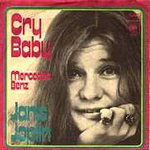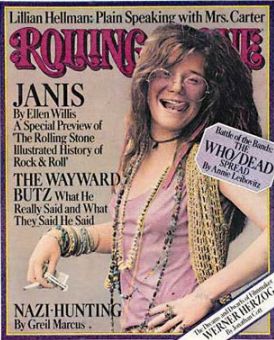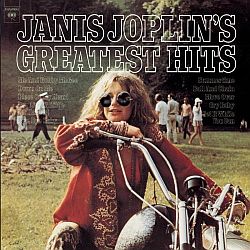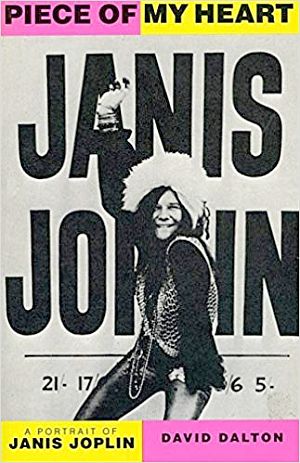In 1995, Mercedes-Benz, the German luxury car maker, used a song by ‘60s rocker and blues singer Janis Joplin in one of its TV ads. The Joplin tune — which includes the famous refrain, “Oh Lord, won’t you buy me a Mercedes Benz” — was used by Mercedes to push a new line of sedans. At first, the use of the song — which Joplin intended as a sarcastic piece on the pursuit of material happiness — seemed a risky if not an odd marketing strategy for the conservative German automaker. Yet there was a method to Mercedes’ madness, and it involved the “maturing” Baby Boomer market. First, consider Ms. Joplin and the times that helped produce the music.
Janis Lyn Joplin was born in Port Arthur, Texas on January 19, 1943. By most accounts, she loved her home and family, but Joplin was an unhappy soul in Port Arthur, especially as a high school teenager. By then she had been singing folk music and blues locally. She later made her way to California and into the 1960s’ music and Hippie scene in San Francisco. In 1966, she teamed up with a band named Big Brother & The Holding Company, and at the 1967 Monterey Pop Festival she captured national attention with a stunning blues performance of “Ball and Chain.” A first album by Joplin and her group, titled Big Brother & The Holding Company, was re-released following the Monterey Pop Festival. The next album, Cheap Thrills, topped the charts in 1968. Joplin then moved on to a solo act, producing another album in 1969 with the Kozmic Blues Band which included one of her famous tunes, “Try (Just a Little Bit Harder)”.
Joplin’s personal life, meanwhile, was troubled, with drug addiction, alcoholism, and unhappy personal relationships. Still, by 1970, her musical stars seemed to be aligning with a new group of musicians backing here — the Full Tilt Boogie Band. She had also made a new attempt at beating her drug habit.
|
Mercedes Benz Joplin: “I’d like to do a song of great social |
| Oh Lord, won’t you buy me a Mercedes Benz? My friends all drive Porsches, I must make amends. Worked hard all my lifetime, no help from my friends, So Lord, won’t you buy me a Mercedes Benz ? |
| Oh Lord, won’t you buy me a color TV ? Dialing For Dollars is trying to find me. I wait for delivery each day until three, So oh Lord, won’t you buy me a color TV ? |
| Oh Lord, won’t you buy me a night on the town ? I’m counting on you, Lord, please don’t let me down. Prove that you love me and buy the next round, Oh Lord, won’t you buy me a night on the town ? |
| Everybody! |
| Oh Lord, won’t you buy me a Mercedes Benz ? My friends all drive Porsches, I must make amends, Worked hard all my lifetime, no help from my friends, So oh Lord, won’t you buy me a Mercedes Benz ? |
| That’s it! (giggle) |
In 1970, Joplin and her group produced the album, Pearl, which included the songs “Mercedes Benz,” “Get It While You Can,” and “Me and Bobby McGee.” But tragically, Joplin relapsed into drug use and died of an overdosed in October 1970. Her newly-made album had yet to go to market. But four months after her death, Pearl topped the album charts for nine weeks, and “Me and Bobby McGee” became a No.1 single in 1971 and one of her biggest hits.
Music Player
Janis Joplin – “Mercedes Benz”
The “Mercedes Benz” song in that album was something of a playful throw-away at the time. It was written by Joplin with Kansas-born Beatnick poet Michael McClure and recorded in a style that was pure Joplinesque, complete with giggle at the end.
Joplin can be heard on the version above talking in the studio, saying she could do the song in “one take,” which she did. The point of her tune — befitting the 1960s’ values around her — was to mock the notion that happiness could be found through material things. Joplin recorded the song a capella, with lyrics that made her message pretty transparent, along with her sarcastic on-air introduction (see sidebar).
25 Years Later
Nearly 25 years later, with Joplin safely in a better place, Mercedes-Benz struck a deal to use the song with Janis’ step-sister. Mercedes then had a marketing problem. It’s line of upscale vehicles were perceived as stuffy — cars that only rich “suits” would buy. The average age of its buyers was getting older, a problem for the future. And the competition was tougher too. The Japanese, with their own new lines of luxury cars, were eating into Mercedes’ turf. So Mercedes decided to work on its image, seeking to dispel the reputation that its cars were only for rich older guys. The New York-based ad agency Lowe & Partners/SMS, known for work on brands such as Grey Poupon mustard, was brought in to help overhaul Mercedes’ sedate image. “The median age of Mercedes buyers is 51,” said veteran adman Marvin Sloves, then chairman of Lowe & Partners/SMS, who explained that Mercedes needed to begin talking to a whole new generation. “I don’t know the generational names,” he said. “Whatever every-one calls people 35 to 45 who grew up in the 1960s and 1970s is the generation we are targeting.” That’s when they made the TV ad using the Joplin tune.
The TV spot became known in the industry as the “Janis ad,” and was designed to soften Boomers’ perception of the Mercedes brand by making it seem less stuffy and more approachable. Mercedes and their admen wanted to show that Mercedes cars could be accessible and fun for younger, successful professionals.
“Mercedes is making a concerted effort to attract nontraditional buyers,” observed Ray Serafin, in February 1995 for Advertising Age. “They’re looking to the future when they’re going to be bringing some different vehicles to the market. They’ve got a sport utility vehicle, to be made in Alabama, coming out in a couple of years, and also a smaller urban type vehicle. So they’re looking at freshening up their image.” Mercedes was also trying to convince Boomers that despite its luxury image, its new line of C-Class and E-Class vehicles in the $32,000 to $40,000 range, were really good, economical buys. So the Janis TV spot ran with those models.
“The campaign revolves around establishing relevancy,” explained Donna Boland, director of public relations for Mercedes-Benz of North America.”The Janis ad fits within that nostalgia mode. It evokes the memories of the ’60s and brings back a good feeling…” Time magazine ranked the Janis ad as the 8th best in 1995. “Sure, sure, it prostitutes the spirit of the 1960s,” said Time in a year-end review of ads, “but the finest car ad of late achieves perfect-pitch simplicity.“The Janis ad fits within that nostalgia mode. It evokes the memories of the ’60s and brings back a good feeling . . .”
– Donna Boland, Mercedes-Benz A new model E-class coasts toward us on the TV screen. The only sound we hear is Joplin belting her classic Mercedes Benz.”
“We’ve been asked why we didn’t use it before, because it seems so natural,” said Boland of the song. “The reason is that the people who really appreciated that music are only now in the right income bracket for our product.” Lee Garfinkel, Lowe & Partners/SMS chief creative officer, explained, “We couldn’t have used this song 25 years ago. Our target audience knows that, and that’s one of the reasons it works so well in the strategy.” A few years after the ad had run, in 1998, Mercedes’ Michael Jackson, then about to become CEO, looked back on the Janis ad and the intent of the campaign in an interview with Brandweek:
. . .Certainly, ‘Janis’ spurred a great deal of conversation internally, as well as through the dealer organization and even customers. But you have to go back to the original plan. The purpose of the brand campaign was to, yes, launch the C-Class and a value story [ i.e., a good buy], but it was a first step in defining Mercedes-Benz in a new way. And the single goal of ‘Janis’ was to communicate that something is changing at Mercedes. Open your mind. We didn’t say how we were changing, or what the meaning was. It was simply a signal that change was taking place. And it was absolutely the most effective TV commercial that we could have run at that time. It achieved the objective of [getting people thinking], “Hey, something changed at Mercedes while I wasn’t looking.”
But what about the fact that Joplin intended the song as a critique of the very thing the ad was now being used for? “These lyrics are certainly among the best known in the rock world,” said Mercedes’ Donna Boland, acknowledging when the ad first came out that there were people upset with it. “. . . There’s always going to be people who are going to dissect something like this . . . “[W]hat’s most annoying about the use of Joplin’s song is the fact that she is dead, and the integrity of her art is all that she has left. Joplin didn’t really want to help sell a damn Mercedes.”
– Dean Bakopoulos, 1996[B]ut I think most of our buyers will understand that we’re harkening back to the ’60s as a whole.” Janis’ fans, however, weren’t so understanding.
While using the Janis ad may well have proved a clever re-casting of a calcifying corporate image — and Mercedes’ sales did increase in the first few years following the Janis ad –it also provoked outrage among music fans and others who felt it a transgression on the emotional connection to the music and the artist’s intent. Among the critics was Dean Bakopoulos writing for the Michigan Daily after he saw the ad in 1996. “What’s most annoying about the use of Joplin’s song,” wrote Bakopoulos, “is the fact that she is dead, and the integrity of her art is all that she has left. Joplin didn’t really want to help sell a damn Mercedes.” But the use of ad, he explained, underscored a bigger issue. “There’s a business culture and an artist culture at work in America,” Bakopoulos wrote, “. . . and they don’t fit together. When their paths cross it comes off as vulgar, disrespectful,” Bakopoulos also offered this:
…What the folks who designed the ad want you to believe is the antithesis to Joplin’s song. They want you to believe that a Mercedes Benz is a reward for all your hard work. But what they really mean is the following: Mercedes Benz is a sign that says, “Look at you. Look at me. Look at my car. Look at your car. Look at my car, again. Ha, ha, sucker! That’s what you get for getting a stupid liberal arts degree.” Mercedes Benz is a sign that you’ve kissed enough ass, lost enough friends and stabbed enough backs to make six figures a year. Well, congratulations….

Early 1970s’ single cover.
Mercedes-Benz, meanwhile — at least in the afterglow of their corporate makeover using Janis Joplin and other strategies — did well in the sales department. By late 1996, the launch of their new E-Class sedan targeting 40-plus Baby Boomers with Janis’s help seemed to be paying off. In fact, during the first eight months of 1996, the entire Mercedes-Benz line — C-Class, E-Class, S-Class, SL-Class and 600 Series — saw a U.S. sales jump of 19.3% to 58,486 vehicles. And the growth continued in following years, with the targeted baby boomers also helping to seed the launch of other new lines such as Mercedes-Benz’ new “cute ute,” as it was called, its M-Class SUV. The Janis message, in fact, rubbed off on other car dealers.
More Use of Janis
In 1999, a print ad for one of Ford’s new Lincoln LS luxury sports sedans used a headline next to a photograph of one of the Lincolns that read: “Oh Lord, won’t you buy me a . . . My, my, my, what have we here?” The familiar verse from the Joplin song was seen as helpful attention getter. Using the verse this way, explained Dave Allen, a senior VP at Young & Rubicam in Irvine, Calif., “allows us to competitively position the Lincoln LS in a smart, surprising way.” Defending the song’s continuing ironic use to sell cars, Allen explained:
Mercedes logo
Joplin’s Legacy
It is not known, of course, what Janis Joplin might have thought about all of this. But in one sense, some of the airing of her name and her song in the “Mercedes” ads may have brought more people to her music and also to learn about her life. And there is a fair amount of material in print and other media about her. In 1973, she was the subject of a feature documentary film, Janis, and there have also been several TV documentaries made about her, including one in VH-1’s “Legends” series. The 1979 film, The Rose, starring Bette Midler, was allegedly based on Joplin’s life. There is also Janis, With Janis Joplin, released by MCA Home Video in June 1987. Other films on Joplin are also being planned. In the summer of 2001, the musical play Love, Janis won acclaim and played to packed houses Off Broadway in New York, but only for a brief run.
See also at this website “Joplin’s Shooting Star, 1966-1970,” which covers more of her career with three song samples and a number of photos. Other story choices can be found at the Annals of Music category page or the Home Page. Thanks for visiting – and if you like what you find here, please make a donation to help support the research and writing at this website. Thank you. – Jack Doyle
________________________________
|
Please Support Thank You |
Date Posted: 10 March 2008
Last Update: 8 March 2019
Comments to: jdoyle@pophistorydig.com
Article Citation:
Jack Doyle, “Selling Janis Joplin, 1995,”
PopHistoryDig.com, March 10,2008.
____________________________
Sources, Links & Additional Information
Richie Unterberger, “Janis Joplin,” All Music Guide.
Bill Sizemore, “Advertisers Put ‘ Big Chill’ on Boomers,” The Virginian-Pilot, Friday, February 24, 1995, p. D-
Associated Press, “Please, Don’t Tell Bobby McGee Advertising: a Janis Joplin Tune Is Reborn in a Mercedes Commercial,”San Jose Mercury News (CA), March 11, 1995, p. D-1.
Marli Murphy, “Is Janis Joplin Laughing From Her Grave or Rolling in It? Who knows? But It is Strange to Hear Her Shilling for Mercedes,” The Kansas City Star, May 29, 1995, p. D-2.
Stuart Elliott, “Middle Age Catches Up With the Me Generation; Getting the Message To Aging Consumers,” New York Times, January 2, 1996.
“Best of 1995,” Time, Monday, December 25, 1995.
David Kiley, “Benz in the Road,” Brandweek, October 26, 1998.
“Mercedes Benz” (song), Wikipedia.org.
Dean Bakopoulos, The Michigan Daily, 1996.
Lael Ewy, “Moulin Rouge, the Erasure of History, and the Disneyfication of the Avant Garde,” East Westerly Review, Issue 7, PostModernVillage .com, Fall 2001.
Lowe & Partners/SMS, “Mercedes Facts”.
Patricia Winters Lauro, “Joplin’s Song In Use Again,” The Media Business: Advertising, New York Times, August 20, 1999.
Jim Burt, “On Chrysler’s Daimler Gambit: You Can’t Please Everyone with Every Ad – and You Shouldn’t Try,” TheCarConnection.com, July 29, 2002.
“Mercedes Benz” by Janis Joplin in video/commercial with a Mercedes driving through rural and urban parts of America, produced by the DNA Production Co., Director – Keir McFarlane, Adcode: benz.drive.68.
Robert Shelton, “Janis Joplin Is Climbing Fast In the Heady Rock Firmament; Singer Makes Her New York Debut With Big Brother & the Holding Company,” New York Times, Monday, February 19, 1968, p. 51.
Mike Jahn, “Janis Joplin Gives A Rousing Display Of Blues and Rock,” New York Times, Saturday, December 20, 1969, p. 36.
Reuters, “Janis Joplin Dies; Rock Star Was 27,” New York Times, Monday, October 5, 1970, p. 1.
Don Heckman, “Janis: She Was Reaching for Musical Maturity,” New York Times, Sunday, May 21, 1972, Arts & Liesure, p. D-30.
Janis, MCA Home Video, Directed and edited by Howard Alk and Seaton Findlay, 1987, 96 minutes.
Janet Maslin, “A Prim Little Girl,” (Review of film, Janis), New York Times, June 7, 1987.
____________________________________




